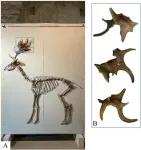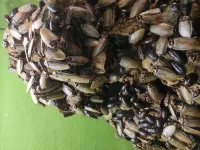(Press-News.org) Study focused on ‘Goldilocks Gene’ CHD2 that causes autism and epilepsy
Deletion of long non-coding RNA CHASERR produces too much CHD2 protein in the cell, leaving patients wheelchair-bound, nonverbal and with intellectual delays
Patient’s dad from study: ‘We intuitively understood this was a lot bigger than just Emma’
‘It is mind-boggling that we only know what 1% of the human genome does’
CHICAGO --- When a gene produces too much protein, it can have devastating consequences on brain development and function. Patients with an overproduction of protein from the chromodomain helicase DNA binding (CHD2) gene can develop a rare and severe neurodevelopmental disorder that renders them wheelchair-bound, nonverbal and with profound intellectual delays.
Now, scientists at Northwestern Medicine and the Broad Institute of MIT and Harvard have discovered an RNA that acts like the brake in one’s car to control how much or how little protein is produced by a gene. In patients with this rare disorder, a long non-coding RNA called CHASERR (CHD2 adjacent, suppressive regulatory RNA) is deleted — the “foot” is taken off the “brake” — and CHD2 protein production goes into overdrive, reports a new Northwestern Medicine study.
The study will be published Oct. 23 in the New England Journal of Medicine.
While most RNAs make proteins, long non-coding RNAs don't make proteins but are crucial for regulating gene activity. Long non-coding RNAs exist in the so-called “Wild West” (99%) of the human genome that is currently understudied.
Not only does this finding have treatment implications for patients with neurodevelopmental disorders such as epilepsy and autism, the study also underscores the need to explore understudied non-coding regions within the human genome.
“There are thousands of long non-coding RNAs, but, until this study, we didn’t know what they did,” said Gemma Carvill, the study’s corresponding author. “One of the things we learned in this study is that the deletion of a specific long non-coding RNA changes the expression of a particular gene called CHD2. We call CHD2 a ‘Goldilocks Gene,’ because both too little is bad and too much is also bad. There's no reason at all to think that this is an isolated case, but more likely that these long non-coding RNAs and non-coding regions are implicated more broadly across human disorders.”
Carvill is an assistant professor of neurology, pharmacology and pediatrics at Northwestern University Feinberg School of Medicine.
Like taking the foot off the brake
The study specifically focused on the CHD2 gene, which causes autism and epilepsy. In 2013, Carvill and colleagues found that in a subset of patients with epilepsy and autism, the CHD2 gene produces too little protein.
This new study, however, examined three patients whose CHD2 gene produced too much protein. The common thread among all three patients was a deletion of the long non-coding RNA CHASERR.
Carvill said future studies that attempt to manipulate CHASERR might have success in controlling the amount of CHD2 protein that is produced, thereby leading to more effective treatments for patients.
Although previous studies in mice by Igor Ulitsky at the Weizmann Institute have found a link between a CHASERR deletion and how much CHD2 protein is produced, this is the first study to find this link in humans. Ulitsky, an expert in the biology of long non-coding RNAs, also is an author on the paper.
“With three patients, we were able to finally classify this as a new disorder,” said co-senior author Anne O'Donnell-Luria, co-director of the Broad Center for Mendelian Genomics and an institute member at the Broad, clinical genetics physician at Boston Children’s Hospital, and an assistant professor of pediatrics at Harvard Medical School. “The unique mechanism we’ve identified here suggests that there are more long non-coding RNAs underlying rare genetic disorders still to be found, which could potentially bring answers for some of the many families still waiting for a rare-disease diagnosis.”
Emma’s story
Emma Broadbent, 8, was the first of the three patients identified for this study. She is wheelchair-bound, non-verbal, uses a feeding tube and has severe intellectual delays. When her dad, Brian Broadbent, learned of Emma’s deletion of CHASERR through her genome sequencing, he began scouring the internet for anyone researching CHD2. He eventually connected with Carvill and other scientists globally, and the resulting research team was able to identify the other two patients with the CHASERR deletion.
“Emma suffers a lot, and this adds purpose to her life because she’s helping science,” said Brian, who is a co-author on the study. “We felt we had a responsibility to push this as forward as much as we can because it's going to impact future children. This is just scratching the surface of something that could be really important. We intuitively understood that this was a lot bigger than just Emma.”
Sequencing the ‘Wild West’ of the human genome
Today, when someone undergoes genetic testing to identify variants or changes that might be linked to genetic disorders or diseases, they first receive gene panels or exome sequencing — which focuses on only 1% of the human genome that codes for proteins.
“It is mind-boggling that we only know what 1% of the human genome does, and we have very little idea what the other 99% does,” Carvill said. “We ignore it, and our study highlights why we shouldn't.”
If scientists don’t find genetic disorders or diseases after exome testing, then they can perform genome testing. But so little is known about the function of the full genome that interpreting the findings can be challenging.
“Everything we currently we know about disease is rooted in a genetic variant in a gene, and that is because that genetic variant either destroys the function of the protein or it alters the function of the protein, but it's all protein based, and that's mostly because we've been doing exome sequencing,” Carvill said. “But we know we're still missing things because there are still a significant percentage of kids in pediatric epilepsies and other disorders as well where we suspect they have a genetic basis, but we just haven't found it yet.”
Implications for future treatments
Currently, patients with epilepsy are treated with antiseizure medications, but this is treating the symptom of the disorder and not the root cause. Additionally, 30% of patients with epilepsy do not respond to current medications. Ideally, Carvill and her team would like to treat patients with epilepsy and other seizure-related disorders with gene-targeting therapies to correct the root cause: the genetic change. Identification of non-coding regions that control gene expression, like CHASERR, is one way her team is thinking about using their knowledge of the human genome to design gene-targeting therapies.
The study is titled, “Neurodevelopmental Disorder Caused by De Novo Deletions in lncRNA Gene."
END
Little-studied RNA might be key to regulating genetic disorders like epilepsy, autism
Future studies that manipulate this RNA could help treat neurodevelopmental diseases in humans
2024-10-23
ELSE PRESS RELEASES FROM THIS DATE:
UB researchers show why cannabis policies should shift to a harm reduction, health promotion approach to safeguard public health
2024-10-23
BUFFALO, N.Y. — Millions of Americans use cannabis to treat a plethora of health conditions. They are rarely under a health care provider’s supervision and their access to quality information about the substances they are consuming and their potential risks is limited at best.
A paper published today in the American Journal of Public Health, the official journal of the American Public Health Association, by University at Buffalo researchers calls attention to this concerning and potentially dangerous situation, which they say is a result of a policy environment historically driven by politics, not science.
The paper explains why there needs to be a shift in cannabis ...
Live well, think well: Research shows healthy habits tied to brain health
2024-10-23
EMBARGOED FOR RELEASE UNTIL 4 P.M. ET, WEDNESDAY, OCTOBER 23, 2024
MINNEAPOLIS – In middle-aged people, having risk factors like blood pressure, blood sugar and cholesterol that are not well-controlled combined with not following certain healthy habits including exercise, diet and sleep, are linked to a higher risk of stroke, dementia or depression later in life, according to a study published in the October 23, 2024, online issue of Neurology®, the medical journal of the American Academy of Neurology. These results do not prove that not having healthy habits increases the risk of these conditions, ...
Could poor sleep in middle age speed up brain aging?
2024-10-23
EMBARGOED FOR RELEASE UNTIL 4 P.M. ET, WEDNESDAY, OCTOBER 23, 2024
MINNEAPOLIS – People in early middle age who have poor sleep quality, including having difficulty falling or staying asleep, have more signs of poor brain health in late middle age, according to a study published in the October 23, 2024, online issue of Neurology®, the medical journal of the American Academy of Neurology. The study does not prove that poor sleep accelerates brain aging. It only shows an association between poor sleep quality and signs ...
Fossils unveil how southern Europe’s ecosystem changed through Glacial-Interglacial Stages
2024-10-23
Fossils from more than 600,000 years ago reveal how Southern Europe’s animal community shifted between warm and cold climate fluctuations, according to a study published October 23, 2024 in the open-access journal PLOS ONE by Beniamino Mecozzi from the Sapienza Università di Roma, Italy and colleagues.
The Notarchirico site has long been valued as a source of information on the Early-Middle Pleistocene, with fossils stretching from around 695 thousand to 614 thousand years ago. The authors of the present study examined mammalian fossils at the site and how they might ...
Your ability to balance on one leg may be a reliable indicator of neuromuscular aging, with men and women showing significant declines over the decades
2024-10-23
Your ability to balance on one leg may be a reliable indicator of neuromuscular aging, with men and women showing significant declines over the decades
###
Article URL: https://journals.plos.org/plosone/article?id=10.1371/journal.pone.0310764
Article Title: Age-related changes in gait, balance, and strength parameters: A cross-sectional study
Author Countries: U.S., Taiwan
Funding: AR-K25AG068368 RJP-Robert and Arlene Kogod Professorship in Geriatric Medicine KRK-W. Hall Wendel, Jr. Musculoskeletal Professorship The funders had no role in study design, data collection and analysis, decision to publish, or preparation of the manuscript. END ...
Most young adults in the UK consider non-consensual condom removal during sex to be wrong and a violation of consent, with almost 9 in 10 seeing it as a form of sexual assault, per survey of 18-25-yea
2024-10-23
Most young adults in the UK consider non-consensual condom removal during sex to be wrong and a violation of consent, with almost 9 in 10 seeing it as a form of sexual assault, per survey of 18-25-year-olds
###
Article URL: https://journals.plos.org/plosone/article?id=10.1371/journal.pone.0298561
Article Title: A UK survey of young people’s views on condom removal during sex
Author Countries: U.K.
Funding: The author(s) received no specific funding for this work. END ...
Under climate change scenarios, 30-44% more land in Ethiopia might become suitable for growing arabica coffee by 2080, although some cultivated areas might also become unsuitable, per modelling study
2024-10-23
Under climate change scenarios, 30-44% more land in Ethiopia might become suitable for growing arabica coffee by 2080, although some cultivated areas might also become unsuitable, per modelling study
###
Article URL: https://journals.plos.org/plosone/article?id=10.1371/journal.pone.0310945
Article Title: Analysis of current and future bioclimatic suitability for C. arabica production in Ethiopia
Author Countries: Ethiopia
Funding: The author(s) received no specific funding for this work. END ...
Cockroaches and maggots might be able to turn an invasive seaweed into a high quality compost, finds a new experimental study which provides hope for the environment and the circular economy
2024-10-23
Cockroaches and maggots might be able to turn an invasive seaweed into a high quality compost, finds a new experimental study which provides hope for the environment and the circular economy
###
Article URL: https://journals.plos.org/plosone/article?id=10.1371/journal.pone.0311483
Article Title: Invertebrate composting quality of the invasive alga Rugulopteryx okamurae, prospects for its bio-recycling, management and circular economy
Author Countries: Spain
Funding: All the financial support has been received by professor Jose Carlos García-Gómez and any funder have influence in the research. The details are: - JCGG (68/83 / 4081/0171) Organization of American ...
Implantable device may prevent death from opioid overdose
2024-10-23
The opioid epidemic claims more 70,000 lives each year in the U.S., and lifesaving interventions are urgently needed. Although naloxone, sold as an over-the-counter nasal spray or injectable, saves lives by quickly restoring normal breathing during an overdose, administrating the medication requires a knowledgeable bystander – limiting its lifesaving potential.
A team from Washington University School of Medicine in St. Louis and Northwestern University in Chicago has developed a device that may rescue people from overdose without bystander help. In animal studies, the researchers found that the implantable device detects an overdose, rapidly delivers naloxone ...
Half of young adults support prison time for non-consensual condom removal
2024-10-23
Almost nine in 10 young adults in the UK believe that removing a condom during sex without the other person’s permission is sexual assault, and around half support prison time as a penalty, finds a new study by UCL researchers.
This is the first UK study to cover views on non-consensual condom removal. It is published in PLOS ONE and surveyed 1,729 people between the ages of 18 and 25, living in the UK.
Young people were chosen as the focus of the study as, out of all demographics, they use condoms the most.
The survey consisted of several examples of non-consensual condom removal, which ...
LAST 30 PRESS RELEASES:
Tracing the quick synthesis of an industrially important catalyst
New software sheds light on cancer’s hidden genetic networks
UT Health San Antonio awarded $3 million in CPRIT grants to bolster cancer research and prevention efforts in South Texas
Third symposium spotlights global challenge of new contaminants in China’s fight against pollution
From straw to soil harmony: International team reveals how biochar supercharges carbon-smart farming
Myeloma: How AI is redrawing the map of cancer care
Manhattan E. Charurat, Ph.D., MHS invested as the Homer and Martha Gudelsky Distinguished Professor in Medicine at the University of Maryland School of Medicine
Insilico Medicine’s Pharma.AI Q4 Winter Launch Recap: Revolutionizing drug discovery with cutting-edge AI innovations, accelerating the path to pharmaceutical superintelligence
Nanoplastics have diet-dependent impacts on digestive system health
Brain neuron death occurs throughout life and increases with age, a natural human protein drug may halt neuron death in Alzheimer’s disease
SPIE and CLP announce the recipients of the 2025 Advanced Photonics Young Innovator Award
Lessons from the Caldor Fire’s Christmas Valley ‘Miracle’
Ant societies rose by trading individual protection for collective power
Research reveals how ancient viral DNA shapes early embryonic development
A molecular gatekeeper that controls protein synthesis
New ‘cloaking device’ concept to shield sensitive tech from magnetic fields
Researchers show impact of mountain building and climate change on alpine biodiversity
Study models the transition from Neanderthals to modern humans in Europe
University of Phoenix College of Doctoral Studies releases white paper on AI-driven skilling to reduce burnout and restore worker autonomy
AIs fail at the game of visual “telephone”
The levers for a sustainable food system
Potential changes in US homelessness by ending federal support for housing first programs
Vulnerability of large language models to prompt injection when providing medical advice
Researchers develop new system for high-energy-density, long-life, multi-electron transfer bromine-based flow batteries
Ending federal support for housing first programs could increase U.S. homelessness by 5% in one year, new JAMA study finds
New research uncovers molecular ‘safety switch’ shielding cancers from immune attack
Bacteria resisting viral infection can still sink carbon to ocean floor
Younger biological age may increase depression risk in older women during COVID-19
Bharat Innovates 2026 National Basecamp Showcases India’s Most Promising Deep-Tech Ventures
Here’s what determines whether your income level rises or falls
[Press-News.org] Little-studied RNA might be key to regulating genetic disorders like epilepsy, autismFuture studies that manipulate this RNA could help treat neurodevelopmental diseases in humans







